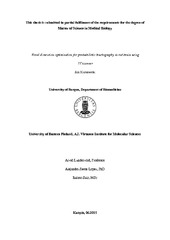Voxel dimension optimization for probabilistic tractography in rat brain using 7T scanner
Master thesis
Permanent lenke
https://hdl.handle.net/1956/10168Utgivelsesdato
2015-06-01Metadata
Vis full innførselSamlinger
Sammendrag
Brain connectivity is an increasingly important research field within neuroscience. Using MRI technology it is now possible to measure diffusion to approximate the location of anatomical tracts in the brain or correlate certain brain activity to obtain information about functional connectivity (Jirsa & McIntosh, 2007). However, those techniques face many challenges and the results obtained are only an approximation of the truth. Processing of such data includes many complicated steps and the final statistical result is sensitive to the quality of acquired images. Diffusion tensor Imaging (DTI) is a technique which is plagued with inherently low signal to noise ratio (SNR) due to e.g. T2* effects and eddy current. T2* effects are a combination of both magnetic field inhomogeneites and susceptibility artifacts (Westbrook & Kaut, 1993). By optimizing the sequence parameters the overall quality of the acquired images can be improved, enabling better quantification. Thus, choosing a proper MRI sequence is crucial while performing an experiment. An optimization step for selecting a proper voxel dimension for DTI is introduced in the thesis. The project consists of image acquisition, statistical analysis and visual comparison between tracking results. Nine different 2D sequences and two 3D sequences were tested with different resolution varying in Field of view (FOV), Number of phase and frequency encoding steps, b value and number of averages. Finally a slice thickness of 0.4 mm was chosen, FOV of 12.8 mm and a matrix 64x64 resulting in 2 h 8 min of scanning time.. All of the experiments were performed on rat brain using 7T preclinical scanner, a similar protocol may be used for optimizing MRI sequences in human studies.
